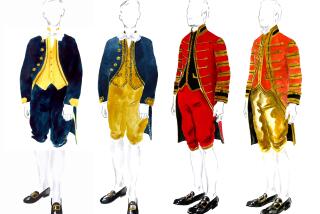Best Sellers Are Often Chips Off the Old Patterns
- Share via
The distance is short between present and past in the timeless world of china production.
“The old patterns have more character, color and personality than typical modern patterns,” says Elizabeth Feagans, a vice president of Royal China & Porcelain Co. in Moorestown, N.J. The company is a U.S. distributor for two English companies, Royal Worcester and Spode.
Last year, Royal Worcester, founded in 1751 in Worcester, reintroduced six 18th- and 19th-Century patterns. They include Sheridan from 1770 and Charlotte, which dates from the 1780s.
The majority of Spode patterns are at least 100 years old, and new patterns are usually adaptations of the old, Feagans says. Spode, founded at Stoke-on-Trent in 1770, counts among old patterns still going strong its Blue Italian, introduced in 1816; Blue Colonel, 1878; Consul, 1890, and Lancaster, 1895. Indian Tree is an 1890 adaptation of an 1810 pattern.
What makes for longevity?
“The first basic is the shape of the cups and holloware,” Feagans says. “Certain shapes are timeless.”
She singles out Spode’s Stafford pattern. The cup, based on Georgian silver forms, is wide at the top and shallow. Other timeless shapes are a footed cup that recalls Grecian pottery and a cylinder shape known as a can-cup.
A pattern’s longevity also increases if it is favored by museums and private collectors. Design, execution and color are also important. Rich colors such as ruby, cobalt and leather green seem to be a hallmark of Royal Worcester’s evergreen patterns.
*
Simplicity also plays a role. Tuxedo has been in continuous production since it was introduced in 1912 by the Lenox Co. of Lawrenceville, N.J. The only ornamentation on ivory is a gold acid-etched border about a quarter-inch wide.
Although casual dinnerware patterns are more ephemeral, some last for decades.
“Well over half of our patterns are old,” says Marsha Everton, vice president of the Pfaltzgraff Co. of York, Pa.
Pfaltzgraff’s Heritage, plain white with a faceted shape based on old English pewter plates, is from the early 1950s. Yorktown, grayish with a blue folk art flower in the center of the plate, is 26 years old.
Founded in 1811, Pfaltzgraff is said to be the oldest American potter in continuous operation. Though known today for dinnerware, the company started with utilitarian wares such as crocks and jugs.
While many of the old favorites continue, others are discontinued after reasonable notice to make way for the new. It used to be that collectors wanting to add to a set or replace a broken piece were left to comb antiques stores, auctions and flea markets.
Now there are services that will search for you, such as Replacements Ltd. in business for 12 years in Greensboro, N.C. Widely-circulated patterns generate the most requests. Replacements’ No. 1 pattern request is for Blue Garland. The china, bearing the brand name of the Johann Haviland China Corp., was a supermarket premium from 1970 to 1990.
“I know what it is immediately when people call and say they want a Johann Haviland pattern with light blue flowers and platinum trim,” customer service manager Donna Moore says.
The price, of course, goes up as the years go by. Even a pattern only recently discontinued will often cost a lot more. A Blue Garland 20-piece service for four was $79 through Johann Haviland’s open stock, according to a 1982 advertisement. One replacement place setting is now $47.
Replacements, Ltd., 1089 Knox Road, P.O. Box 26029, Greensboro, N.C. 27420. Telephone (919) 697-3000.
More to Read
Inside the business of entertainment
The Wide Shot brings you news, analysis and insights on everything from streaming wars to production — and what it all means for the future.
You may occasionally receive promotional content from the Los Angeles Times.









